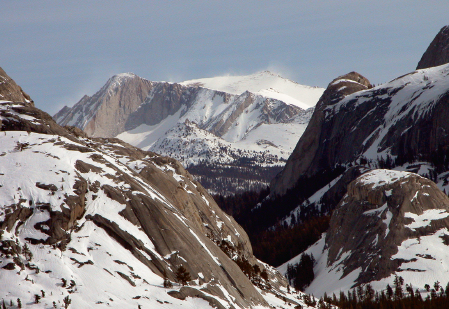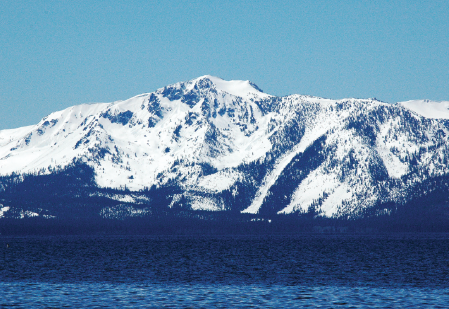Skiing along the John Muir Trail in Yosemite rates as a lifetime highlight, but I could have done without the “Sierra cement.” Pounds of snow clung to the bottom of my skis, and my companions’ also, slowing us like anchors for miles on end. We managed to muscle our way over Donohue Pass and complete our journey to Mammoth Lakes anyway. I’ll never forget that outstanding adventure, nor to take enough wax on a ski trip again.
My younger self could not fathom the idea of turning 50. But as I reached the milestone recently, I’m grateful to still enjoy skiing and other outdoor activities that I picked up in my youth. Following are lessons I’ve learned (often the hard way) over the years. This installment, the first of five, focuses on winter pursuits.

1. Give snowshoeing a try.
You’ll have whole snow-covered mountain ranges to yourself. Then once you get a taste of winter adventure, try cross country skiing for more speed and fun. It’s much cheaper and safer than downhill skiing. Don’t hesitate to rent gear before buying. That will help you learn what equipment you want and spend more wisely to get it.
2. Dress in layers, avoiding cotton.
Whether you’re out on a clear day or caught in a winter storm, fabrics like wool or polypropylene insulate your body temperature even when wet. Cotton does the opposite, trapping moisture (including your own sweat) that chills next to your skin. After I shivered needlessly through cold days and nights, I learned that it’s better to pay more for the right clothes.
3. Carry skins (sticky fabric strips) and wax for your cross-country skis, even if they are “waxless.”
Skins will help you climb hills which are too steep for your skis to ascend without additional friction to prevent you from sliding backward. In addition to preventing snow from sticking to your skis, wax will help increase your glide, speed and efficiency.
4. Time your outings wisely.
Skiing in March beats skiing in December. Early spring will probably provide better snow and definitely delivers longer and warmer days. That’s not to say that you can’t have a good outing in early winter, but odds are that conditions improve later in the season.

Even if clouds fill the sky, its ultraviolet light can still burn your skin quickly at high elevation. On my first cross country ski outing as a young adult, I foolishly took no sun precautions on a spring day at Sonora Pass. The resulting sunburn fried my face and left me with red skin and blisters for weeks. Sunscreen and lip balm help, and covering your skin helps more.
6. Avoid stormy weather.
Deep, fresh powder makes you fight for every step and can slow one’s pace to several hours per mile. Heavy snowfall is good but that doesn’t mean you have to be there when it arrives. Waiting several days after a storm allows snow to settle, which makes for easier snowshoeing and skiing. Visibility will improve also, and if you’re lucky, someone else will break the trail you want to use for you.
7. Drive smart. If you think you might need chains, you need chains.
Stop and put them on your tires, even if it’s cold and stormy outside. Carry emergency supplies, like food, water, blankets and flashlights. Taking a day off to avoid weekend traffic increases your safety and pays you back with a better trip.
8. When you’re ready for even more adventure, try snow camping.
Read up about winter gear: choose a good tent, stove, and sleeping bag. Carry a snow shovel to flatten your camp site. It’s not a bad idea to try this close to a road and your car on your first time out.
9. How to stay warm when camping in cold weather?
An inflatable mattress will insulate your body temperature from the snowpack beneath you, providing a warmer night’s sleep than a foam pad. Check for leaks before you go! Another tip: heat water, fill your bottle and take it into your sleeping bag with you. Make sure the bottle is closed securely! Even if you don’t heat your water, taking your bottle into your sleeping bag will prevent it from freezing overnight.
10. Start your outing early in the day.
Stories abound about skiers and snowshoers caught out after dark and forced to spend a night in the snow. For example, Yosemite’s Ostrander Ski Hut has “benighted” scores of would-be visitors on its ten-mile trek from Badger Pass, including yours truly, twice! Neither would have happened if I had started mid-morning instead of midday or mid-afternoon. At least I was prepared to “bivvy” comfortably the second time, which leads to a related point: carry emergency overnight gear on long day trips.
Don’t let these words of caution give you the wrong idea. Four trans-Sierra treks and scores of shorter snow outings rate among my favorite outdoor memories. Winter presents unique challenges but advice and experience will help you rise to meet them. Millions live within a few hours of California’s snow country, but just a fraction of them enjoy public lands in winter. If you join us, I think you will be glad you did.






